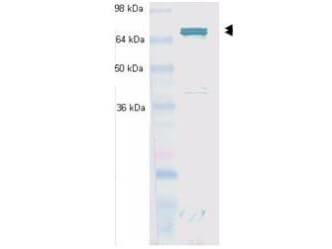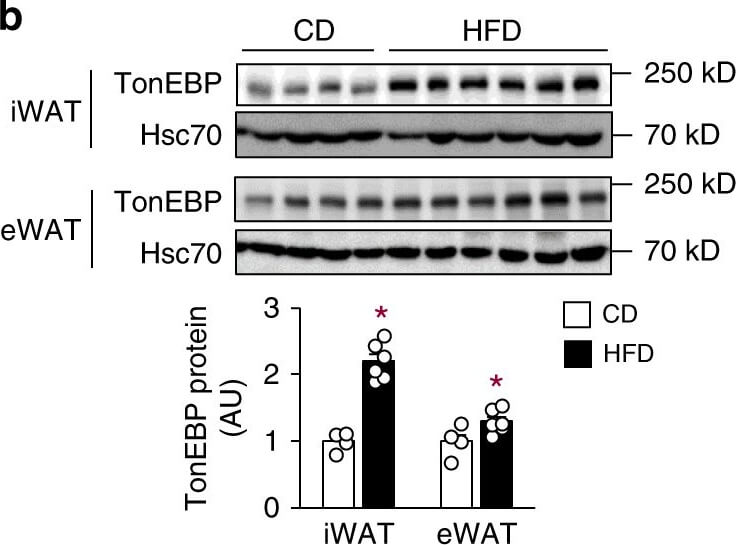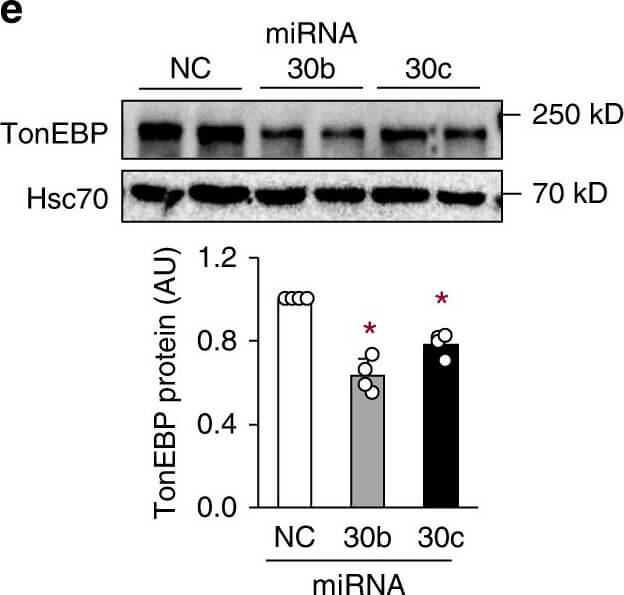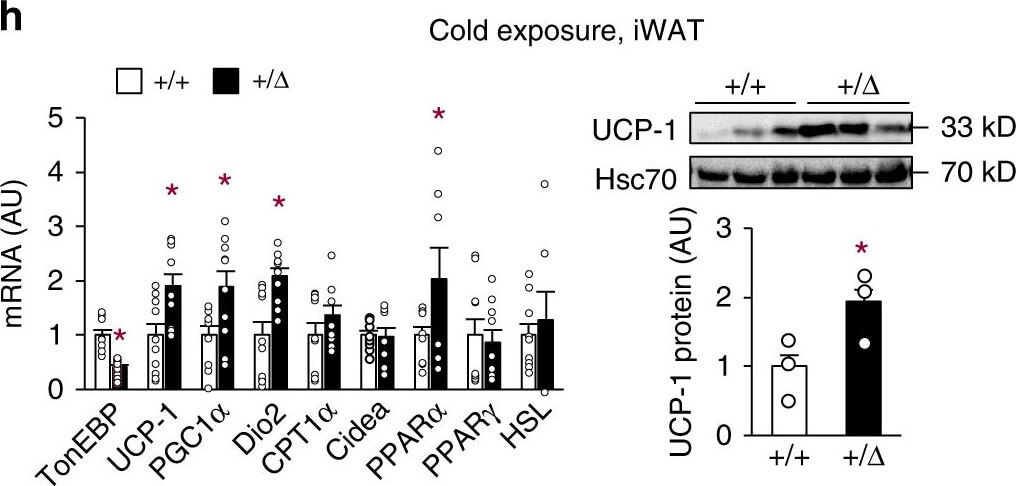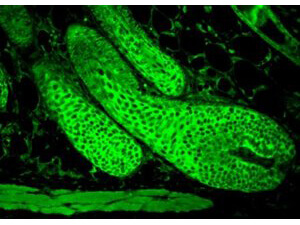Datasheet is currently unavailable. Try again or CONTACT US
Hsc70 (Hsp73) Antibody
Mouse Monoclonal N27F3-4 IgG1
4 References
200-301-A28
100 µg
Liquid (sterile filtered)
WB, IHC, IF, FC, IP
Human, Mouse, Rat, Beluga, Bovine, C. elegans, Carp, Chicken, Cucumber, D. melanogaster, Dog, Guinea Pig, Hamster, Monkey, Pea, Pig, Rabbit, Salmon, Sheep, Trout, Xenopus
Mouse
Shipping info:
$50.00 to US & $70.00 to Canada for most products. Final costs are calculated at checkout.
Product Details
Anti-HSC70 (HSP73) (MOUSE) Monoclonal Antibody - 200-301-A28
Heat shock cognate protein 71-kDa antibody, Heat shock protein 8 antibody, Heat-shock70-KD protein 10, formerly antibody, HSC54 antibody, HSC71 antibody, Hsc54, Hsc71, Hsc73, Hsp71, Hsp73, HspA10, HspA8, LAP1, NIP71, Heat shock cognate 71 kDa protein, Heat shock 70 kDa protein 8
Mouse
Monoclonal
IgG1
Target Details
HSPA8 - View All HSPA8 Products
Human, Mouse, Rat, Beluga, Bovine, C. elegans, Carp, Chicken, Cucumber, D. melanogaster, Dog, Guinea Pig, Hamster, Monkey, Pea, Pig, Rabbit, Salmon, Sheep, Trout, Xenopus
Conjugated Peptide
This Protein G purified monoclonal antibody was prepared using conventional hybridoma technology after repeated immunizations with a synthetic peptide corresponding to a region of human Hsc70 (Hsp73) protein.
This Protein G purified monoclonal antibody reacts with human Hsc70 (Hsp73) protein. A BLAST analysis was used to suggest cross-reactivity with Hsc70 from human, bovine, mouse, rat, C.elegans, beluga, dog, chicken, Drosophila, carp, salmon, trout, guinea pig, hamster, monkey, pig, cucumber, pea, rabbit, sheep and Xenopus sources based on 100% homology with the immunizing sequence. This antibody recognizes both the inducible hsp and the constitutively expressed hsc as 72 kDa and 73 kDa proteins, respectively. Cross-reactivity with Hsp70 from other sources has not been determined.
Application Details
FC, IF, IHC, IP, WB
This Protein G purified antibody has been tested for use in western blotting, immunoelectron microscopy, immunohistochemistry and immunoprecipitation. Specific conditions for reactivity should be optimized by the end user. Expect a doublet band approximately 72/73 kDa in size corresponding to Hsc70 (Hsp73) by western blotting in the appropriate cell lysate or extract. In general, a 1:1,000 dilution is suggested for most applications and is suitable to detect Hsc70 (Hsp73) in 20 µg of heat shocked HeLa cell lysate by western blotting.
Formulation
1.0 mg/mL by UV absorbance at 280 nm
0.02 M Potassium Phosphate, 0.15 M Sodium Chloride, pH 7.2
0.1% (w/v) Sodium Azide
50% (v/v) Glycerol
Shipping & Handling
Wet Ice
Store vial at -20° C prior to opening. This product is stable for several weeks at 4° C as an undiluted liquid. Dilute only prior to immediate use. For extended storage aliquot contents and freeze at -20° C or below. Avoid cycles of freezing and thawing.
Expiration date is one (1) year from date of receipt.
Hsp70 genes encode abundant heat-inducible 70-kDa hsps (hsp70s). In most eukaryotes, hsp70 genes exist as part of a multigene family. Hsp70s are found in most cellular compartments of eukaryotes, including nuclei, mitochondria, chloroplasts, the endoplasmic reticulum and the cytosol, as well as in bacteria. The genes show a high degree of conservation, having at least 50% identity (2). The N-terminal two-thirds of hsp70s are more conserved than the C-terminal one-third. Hsp70 binds ATP with high affinity and possesses a weak ATPase activity which can be stimulated by binding to unfolded proteins and synthetic peptides (3). When hsc70 (constitutively expressed) present in mammalian cells was truncated, ATP binding activity was found to reside in an N-terminal fragment of 44 kDa which lacked peptide binding capacity. Polypeptide binding ability therefore resided within the C-terminal half (4). The structure of this ATP binding domain displays multiple features of nucleotide binding proteins (5). All hsp70s, regardless of location, bind proteins, particularly unfolded ones. The molecular chaperones of the hsp70 family recognize and bind to nascent polypeptide chains as well as partially folded intermediates of proteins, preventing their aggregation and misfolding. The binding of ATP triggers a critical conformational change leading to the release of the bound substrate protein (6). The universal ability of hsp70s to undergo cycles of binding to and release from hydrophobic stretches of partially unfolded proteins determines their role in a great variety of vital intracellular functions such as protein synthesis, protein folding and oligomerization, and protein transport.
Kim DH et al. (2021). Transcription factor TonEBP stimulates hyperosmolality-dependent arginine vasopressin gene expression in the mouse hypothalamus. Front Endocrinol (Lausanne).
Applications
WB, IB, PCA
Y BJ et al. (2020). TonEBP in dendritic cells mediates pro-inflammatory maturation and Th1/Th17 responses. Cell Death Dis.
Applications
WB, IB, PCA
Lee HH et al. (2019). TonEBP/NFAT5 promotes obesity and insulin resistance by epigenetic suppression of white adipose tissue beiging. Nat Commun.
Applications
WB, IB, PCA
Lee et al. (2016). LPS-induced NFκB enhanceosome requires TonEBP/NFAT5 without DNA binding. Scientific Reports
Applications
WB, IB, PCA
This product is for research use only and is not intended for therapeutic or diagnostic applications. Please contact a technical service representative for more information. All products of animal origin manufactured by Rockland Immunochemicals are derived from starting materials of North American origin. Collection was performed in United States Department of Agriculture (USDA) inspected facilities and all materials have been inspected and certified to be free of disease and suitable for exportation. All properties listed are typical characteristics and are not specifications. All suggestions and data are offered in good faith but without guarantee as conditions and methods of use of our products are beyond our control. All claims must be made within 30 days following the date of delivery. The prospective user must determine the suitability of our materials before adopting them on a commercial scale. Suggested uses of our products are not recommendations to use our products in violation of any patent or as a license under any patent of Rockland Immunochemicals, Inc. If you require a commercial license to use this material and do not have one, then return this material, unopened to: Rockland Inc., P.O. BOX 5199, Limerick, Pennsylvania, USA.

